Evaluation of Field Applicability of Sewage Treated with an Electrochemical Floatation System Coupled with a Separation Membrane Process
Abstract
1. Introduction
2. Materials and Methods
2.1. Influent Water-Quality Characteristics
2.2. Characteristics and Configuration of the System
2.3. Experimental Methods
2.4. Analytical Methods
3. Results and Discussion
3.1. Bubble-Size Analysis
3.2. Evaluation of Treatment Efficiency According to Current Density of the DSA
3.3. Evaluation of the Treatment Efficiency of the EFS
solid reduction, adsorption, flocculation
3.4. Pressure Change in the Separation Membrane Process Depending on the Input of Anti-Scalants
3.5. Performance of the Sewage-Reuse System (EFS + MF/RO)
4. Conclusions
Author Contributions
Funding
Data Availability Statement
Conflicts of Interest
References
- WHO. Guideline for the Safe Use of Wastewaters, Excreta and Greywater; World Health Organization: Geneva, Switzerland, 2006. [Google Scholar]
- Hochstrat, R.; Wintgens, T.; Melin, T.; Jeffrey, P. Assessing the European wastewater reclamation and reuse potential—A scenario analysis. Desalination 2006, 188, 1–8. [Google Scholar] [CrossRef]
- Togna, A.P.; Bohner, A.; Webster, T.; Guarini, W.; Sutton, P.M.; Murray, M.; Robinson, S.; Presgrave, C. Membrane biological reactor system development for treatment of high-strength industrial wastewater. In Proceedings of the WEFTEC, Annual Technical Exhibition & Conference 75th, Chicago, IL, USA, 26–30 September 2002; Volume 108. [Google Scholar]
- Sadr Ghayeni, S.B.; Beatson, P.J.; Schneider, R.P.; Fane, A.G. Water reclamation from municipal wastewater using combined microfiltration-reverse osmosis (ME-RO): Preliminary performance data and microbiological aspects of system operation. Desalination 1998, 116, 65–80. [Google Scholar] [CrossRef]
- Lee, K.W.; Kim, H.K. A study on the interrelation among organic pollutant indices of non-biodegradable paper wastewater. J. Korean Soc. Wat. Sci. Tech. 2008, 16, 15–23. [Google Scholar]
- Bard, A.J.; Faulkner, L.R. Electrochemical Methods: Fundamentals and Applications, 2nd ed.; John Wiley & Sons: Hoboken, NJ, USA, 2001. [Google Scholar]
- Marshall, A.T.; Sunde, S.; Tsypkin, M.; Tunold, R. Performance of a PEM water Electrolysis Cell Using IrxRuyTazO2 electrocatalysts for the oxygen evolution Electrode. Int. J. Hydrogen Energy 2007, 32, 2320–2324. [Google Scholar] [CrossRef]
- Takasu, Y.; Sugimoto, W.; Nishiki, Y.; Nakamatsu, S. Structural analyses of RuO2-TiO2/Ti and IrO2-RuO2/Ti anodes used in industrial chlor-alkali membrane processes. J. Appl. Electrochem. 2010, 40, 1789–1795. [Google Scholar] [CrossRef]
- Moats, M.; Hardee, K.; Brown, C. Mesh-on-lead anodes for copper electrowinning. JOM 2003, 55, 46–48. [Google Scholar] [CrossRef]
- Costa, C.R.; Botta, C.M.R.; Espindola, E.L.G.; Olivi, P. Electrochemical treatment of tannery wastewater using DSA electrodes. J. Hazard. Mater. 2008, 153, 616–627. [Google Scholar] [CrossRef]
- Kim, K.W.; Lee, E.H.; Kim, J.S.; Shin, K.H.; Jung, B.I.; Kim, K.H. Performance improvement of Ir oxide electrode for organic destruction. Korean Chem. Eng. Res. 2002, 40, 146–151. [Google Scholar]
- Bertazzoli, L.; Pelegrini, R. Photoelectrochemical discoloration and degradation of organic pollutants in aqueous solutions. Quim. Nova 2002, 25, 477–482. [Google Scholar]
- Profeti, D.; Lassali, T.A.F.; Olivi, P. Preparation of Ir0.3Sn(0.7−x)TixO2 electrodes by the polymeric precursor method: Characterization and lifetime study. J. Appl. Electrochem. 2006, 36, 883–888. [Google Scholar] [CrossRef]
- Santos, T.É.S.; Silva, R.S.; Eguiluz, K.I.B.; Salazar-Banda, G.R. Development of Ti/(RuO2)0.8(Mo2)0.2 (M= Ce, Sn, or Ir) Anodes for atrazine Electro-Oxidation: Influence of the Synthesis method. Mater. Lett. 2015, 146, 4–8. [Google Scholar] [CrossRef]
- Li, P.; Zhao, Y.; Ding, B.; Wang, L. Effect of calcination temperature and molar ratio of tin and manganese on capacitance of Ti/SnO2-Sb-Mn/β-PbO2 electrode during phenol electro-oxidation. J. Electroanal. Chem. 2015, 747, 45–52. [Google Scholar] [CrossRef]
- Dbira, S.; Bensalah, N.; Cañizares, P.; Rodrigo, M.A.; Bedoui, A. The Electrolytic treatment of synthetic urine Using DSA Electrodes. J. Electroanal. Chem. 2015, 744, 62–68. [Google Scholar] [CrossRef]
- Baddouh, A.; Bessegato, G.G.; Rguiti, M.M.; El Ibrahimi, B.E.; Bazzi, L.; Hilali, M.; Zanoni, M.V.B. Electrochemical decolorization of rhodamine b dye: Influence of anode material, chloride concentration and current density. J. Environ. Chem. Eng. 2018, 6, 2041–2047. [Google Scholar] [CrossRef]
- Yu, H.C.; Park, S.C. Electrochemical treatment of wastewater containing Fluoride. J. Korean Soc. Environ. Eng. 2007, 15, 71–79. [Google Scholar]
- Yu, J.J.; Min, K.S.; Park, J.M. Treatment characteristics of refractory compounds in dying wastewater by electrocatalytic electrode. J. Korean Soc. Environ. Eng. 2003, 25, 1277–1282. [Google Scholar]
- Yan, Z.; Zhao, Y.; Zhang, Z.; Li, G.; Li, H.; Wang, J.; Feng, Z.; Tang, M.; Yuan, X.; Zhang, R.; et al. A Study on the Performance of IrO2-Ta2O5 Coated anodes with Surface Treated Ti Substrates. Electrochim. Acta 2015, 157, 345–350. [Google Scholar] [CrossRef]
- Yan, Z.; Li, G.; Wang, J.; Zhang, Z.; Feng, Z.; Tang, M.; Zhang, R. Electro-catalytic study of IrO2Ta2O5 coated anodes with pretreated titanium substrates. J. Alloys Compd. 2016, 680, 60–66. [Google Scholar] [CrossRef]
- Kawaguchi, K.; Morimitsu, M. Effects of Oxide Composition on Structure, Surface Morphology, and Oxygen Evolution Behaviors of IrO2-Ta2O5/Ti Anodes Prepared at a High Temperature. Electrochemistry 2015, 83, 256–261. [Google Scholar] [CrossRef]
- ISO 20298-1; Fine Bubble Technology—Sampling and Sample Preparation for Measurement—Part 1: Ultrafine Bubble Dispersion in Water. ISO: Geneva, Switzerland, 2018.
- Zhou, Z.A.; Xu, Z.; Finch, J.A.; Masliyah, J.H.; Chow, R.S. On the role of cavitation in particle collection in flotation—A critical review. Miner. Eng. 2009, 22, 419–433. [Google Scholar] [CrossRef]
- Te Poele, S.T.; Van Der Graaf, J. Enzymatic cleaning in ultrafiltration of wastewater treatment plant effluent. Desalination 2005, 179, 73–81. [Google Scholar] [CrossRef]
- Laabs, C.N.; Amy, G.L.; Jekel, M. Understanding the size and character of fouling-causing substances from effluent organic matter (EfOM) in low-pressure membrane filtration. Environ. Sci. Technol. 2006, 40, 4495–4499. [Google Scholar] [CrossRef] [PubMed]
- Jüttner, K.; Galla, U.; Schmieder, H. Electrochemical approaches to environmental problems in the process industry. Electrochim. Acta 2000, 45, 2575–2594. [Google Scholar] [CrossRef]
- Kim, D.S.; Park, Y.S. A study on the preparation of the dimensionally stable anode (DSA) with high generation rate of oxidants (I). J. Environ. Sci. Int. 2009, 18, 49–60. [Google Scholar]
- Park, S.R.; Park, J.S. An Updated Review of Recent Studies on Dimensionally Stable Anodes (DSA). J. Korean Electrochem. Soc. 2020, 23, 1–10. [Google Scholar]
- Goyal, A.; Srivastava, V.C. Treatment of highly acidic wastewater containing high energetic compounds using dimensionally stable anode. Chem. Eng. J. 2017, 325, 289–299. [Google Scholar] [CrossRef]
- Markou, V.; Kontogianni, M.C.; Frontistis, Z.; Tekerlekopoulou, A.G.; Katsaounis, A.; Vayenas, D. Electrochemical treatment of biologically pretreated dairy wastewater using dimensionally stable anodes. J. Environ. Manag. 2017, 202, 217–224. [Google Scholar] [CrossRef]
- Cotillas, S.; Llanos, J.; Castro-Ríos, K.; Taborda-Ocampo, G.; Rodrigo, M.A.; Cañizares, P. Synergistic integration of sonochemical and electrochemical disinfection with DSA anodes. Chemosphere 2016, 163, 562–568. [Google Scholar] [CrossRef]
- Lee, C.-H.; Kim, G.Y.; Kim, H.-S.; Kim, J.-K.; Lee, K.-I. Applicability evaluation of microbubble for membrane fouling reduction in wastewater reuse membrane process. J. Korean Soc. Water Wastewater 2017, 31, 169–175. [Google Scholar] [CrossRef]
- Roorda, J.H.; Wortel, N.C.; van Dalen, R. New process for treatment of organically fouled water: Experiences with WWTP effluent. Desalination 2005, 178, 141–148. [Google Scholar] [CrossRef]
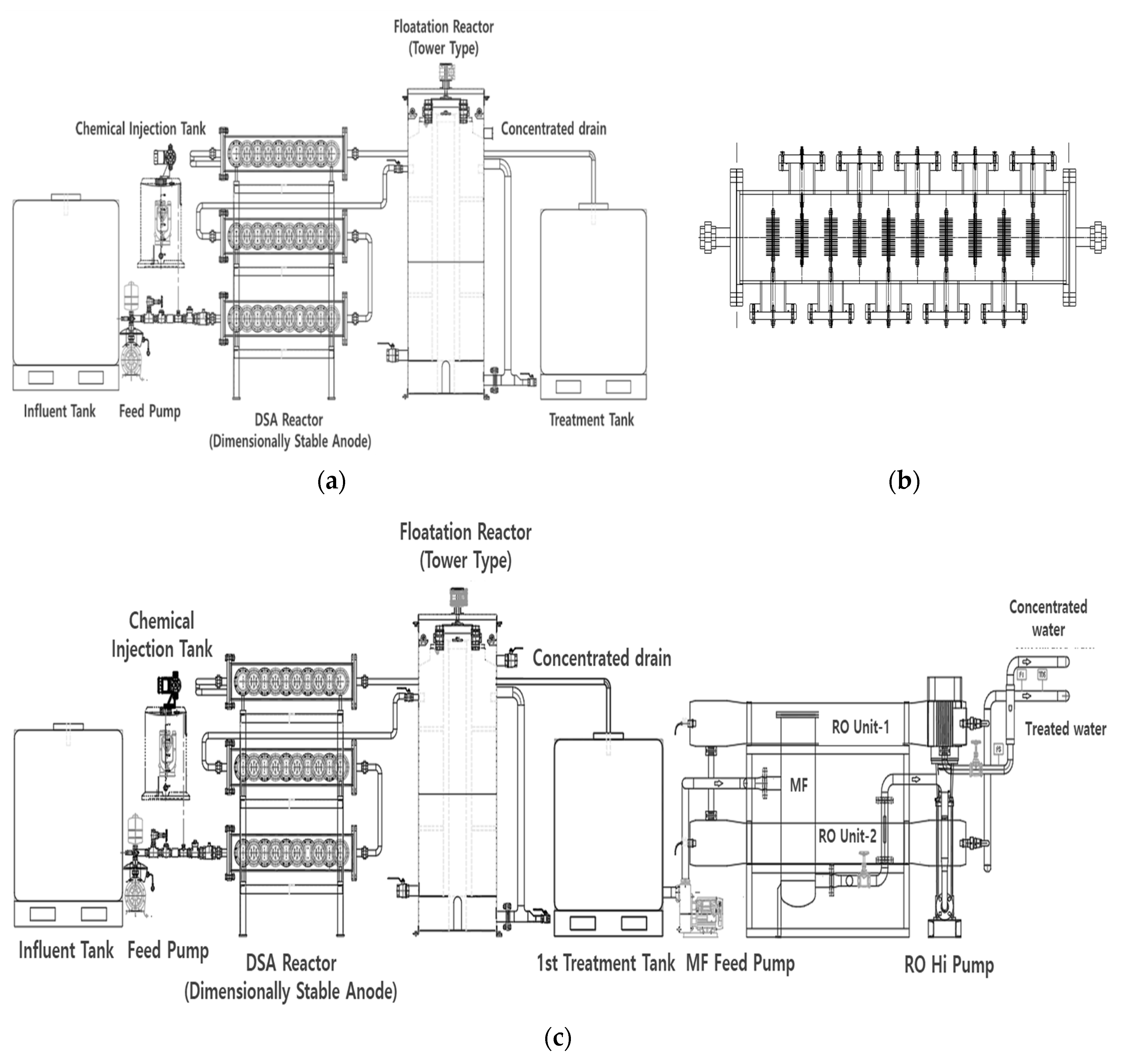



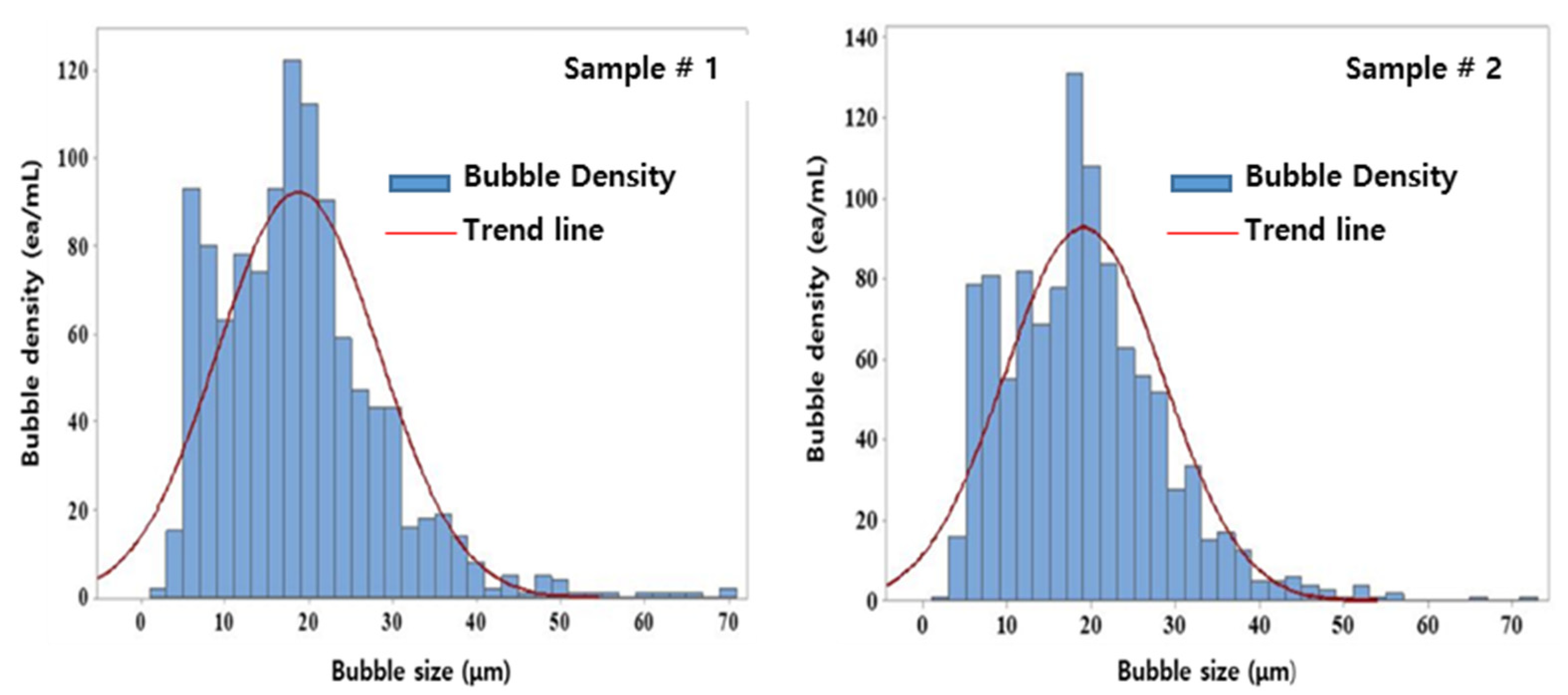
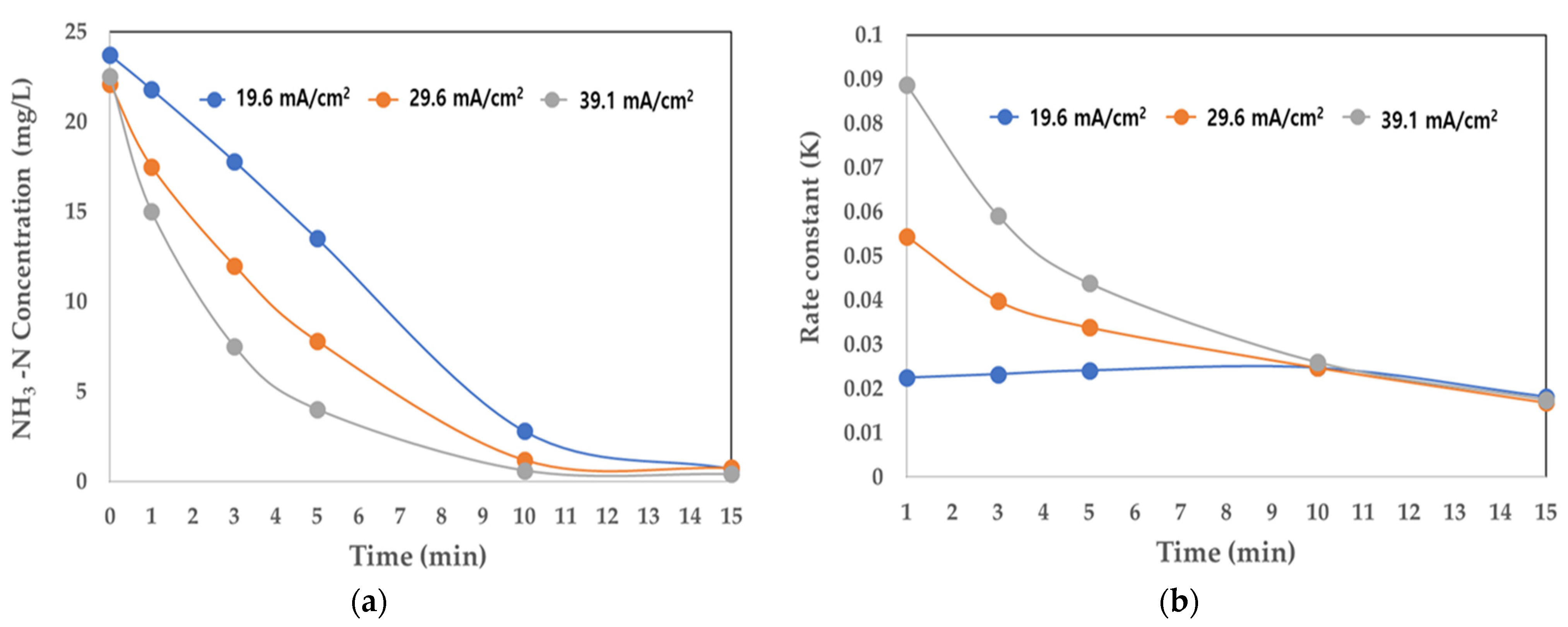
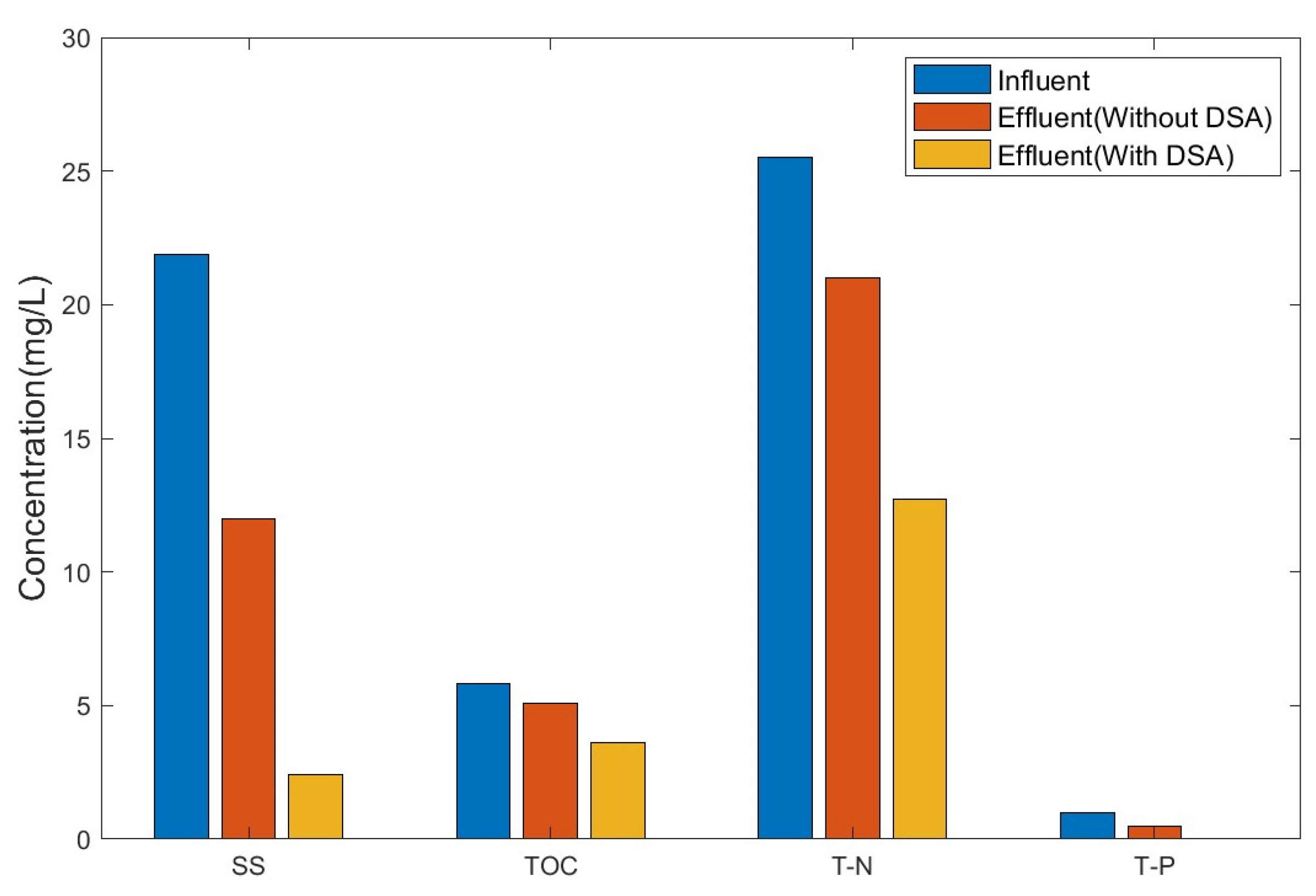
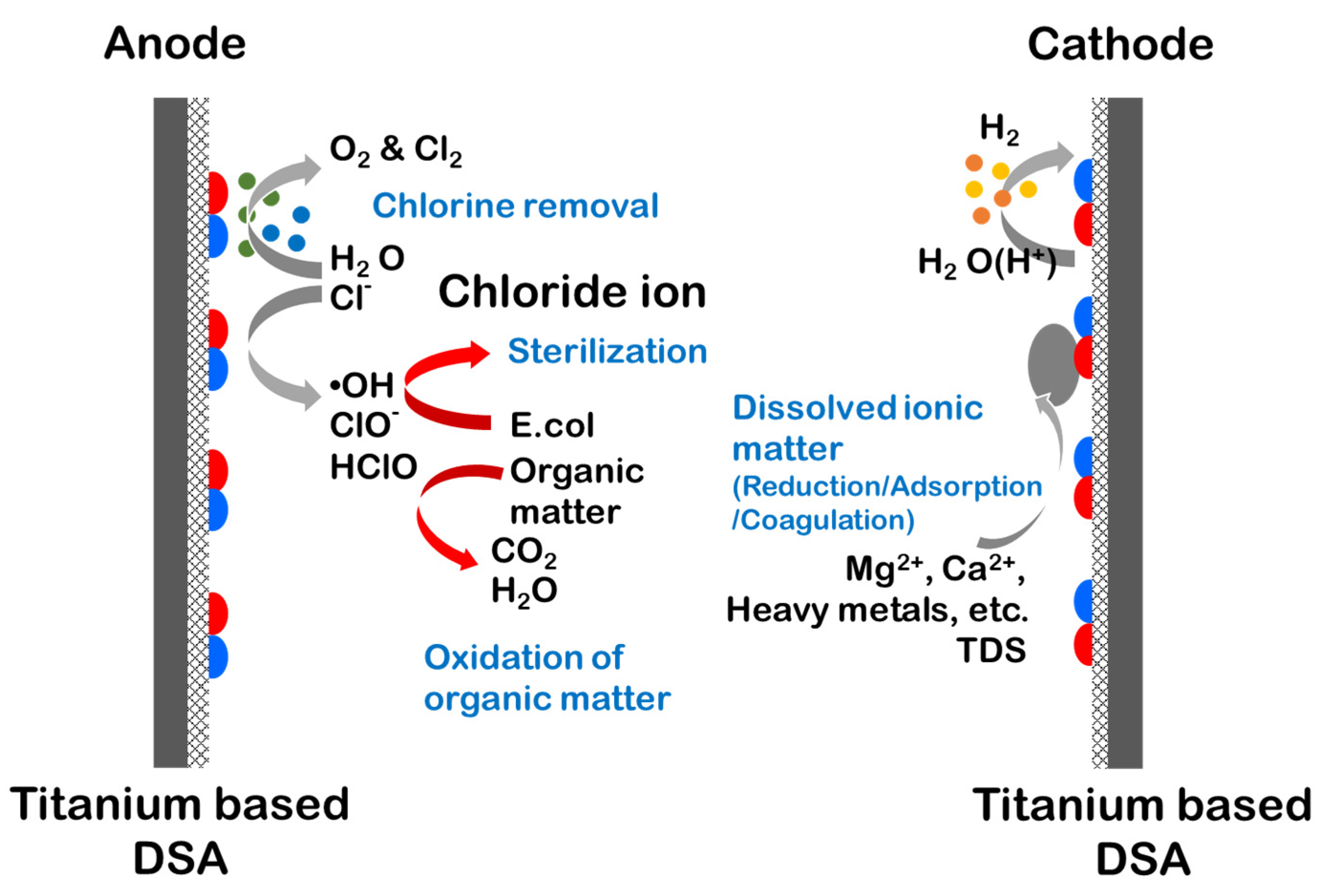

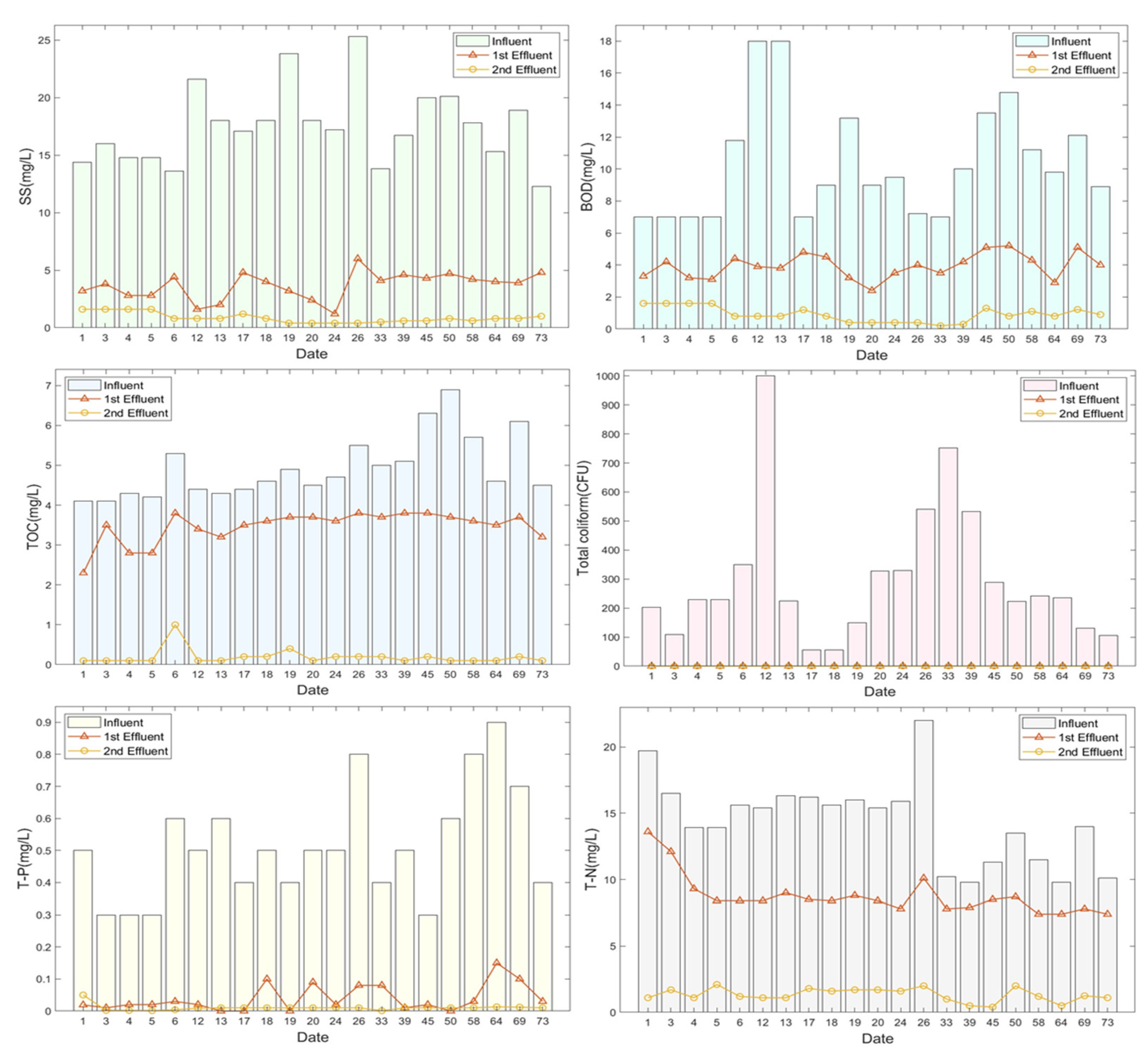
| Water-Quality Parameters | Influent (mg/L) | |
|---|---|---|
| Range | Mean | |
| Suspended solids (SS) | 16.0–25.3 | 17.5 |
| Biochemical oxygen demand (BOD) | 7.0–14.8 | 10.38 |
| Total organic carbon (TOC) | 4.1–6.9 | 4.92 |
| Total nitrogen (TN) | 9.8–16.3 | 14.4 |
| Total phosphorous (TP) | 0.3–0.9 | 0.514 |
| Chloride ion (Cl−) | 57.3–124.3 | 77.3 |
| Conductivity (S/m) | 165–495 | 295 |
| Total coliform (colony forming unit, CFU) | 56.0–4250 | 300.4 |
| Current density (mA/cm2) | 19.6 | 29.6 | 39.1 |
| Current (A) | 1.66 | 2.50 | 3.30 |
| Specific surface area (cm2) | 84.5 | ||
| Variable | N | Average (μm) | Standard Error of the Average (μm) | Standard Deviation (μm) | Minimum Value (μm) | Q1 (μm) | Median Value (μm) | Q3 (μm) | Maximum Value (μm) |
|---|---|---|---|---|---|---|---|---|---|
| SAMPLE1 | 1.115 | 18.712 | 0.290 | 9.671 | 2.700 | 11.300 | 18.000 | 23.500 | 70.700 |
| SAMPLE2 | 1.095 | 19.005 | 0.285 | 9.414 | 2.700 | 11.900 | 18.200 | 24.000 | 72.900 |
| Current Density (mA/cm2) | Concentration of NH3-N (mg/L) | Rate Constant (K) | |||||||||
|---|---|---|---|---|---|---|---|---|---|---|---|
| 0 min | 1 min | 3 min | 5 min | 10 min | 15 min | 1 min | 3 min | 5 min | 10 min | 15 min | |
| 19.6 | 23.7 | 21.8 | 17.8 | 13.5 | 2.8 | 0.7 | 0.022 | 0.023 | 0.024 | 0.025 | 0.018 |
| 29.6 | 22.1 | 17.5 | 12.0 | 7.8 | 1.2 | 0.75 | 0.054 | 0.040 | 0.034 | 0.025 | 0.017 |
| 39.1 | 22.5 | 15.0 | 7.5 | 4.0 | 0.6 | 0.4 | 0.089 | 0.059 | 0.044 | 0.026 | 0.017 |
| Without DSA 1 | With DSA 2 | |||||
|---|---|---|---|---|---|---|
| Influent (mg/L) | Effluent (mg/L) | Removal Efficiency (%) | Influent (mg/L) | Effluent (mg/L) | Removal Efficiency (%) | |
| SS | 21.9 | 12.0 | 45.2 | 21.9 | 2.4 | 86.0 |
| TOC | 5.8 | 5.1 | 10.3 | 5.8 | 3.6 | 37.9 |
| TN | 25.5 | 21.0 | 17.6 | 25.5 | 12.7 | 50.2 |
| TP | 0.97 | 0.48 | 50.5 | 0.97 | 0.04 | 92.8 |
| Total coliform | 530.0 (CFU) | 510 (CFU) | 3.8 | 530.0 (CFU) | ND | 100.0 |
| Pollutant | Anode | Cathode | Operating Condition (Current Density @ Time) | Performance (% Removal) |
|---|---|---|---|---|
| Wastewater [30] (COD 643,000 ± 50,000 mg/L) | Ti/RuO2 | Ti/RuO2 | 720 A/m2 @ 150 min | COD 48.83% |
| Dairy wastewater [31] (COD of 4000 mg/L) | Ti/IrO2 | Zirconium bar | 200 mA/cm2 @ 360 min | COD 96.70% |
| E. coli [32] | Ti/RuO2 | Stainless steel | 11.5 mA/cm2 | E. coli 100% |
| Sewage water * (TOC of 7.8 mg/L) | Ti-based DSA | Ti-based DSA | 19.6 mA/cm2 @ 10 min | SS 81.7%, TOC 32.5%, TN 41.6%, TP 92.8% E. coli 100% |
| Parameters | Influent (mg/L) | EFS (1st) | EFS + MF/RO (2nd) | ||
|---|---|---|---|---|---|
| Effluent (mg/L) | Average Removal Efficiency (%) | Effluent (mg/L) | Average Removal Efficiency (%) | ||
| SS | 16.0–25.3 (17.5) * | 2.0–4.8 (3.20) * | 81.7 | 0.40–1.6 (0.86) * | 94.7 |
| BOD | 7.0–14.8 (10.38) * | 2.4–5.2 (3.93) * | 62.1 | 0.2–1.22 (0.91) * | 90.0 |
| TOC | 4.1–6.9 (4.92) * | 2.3–3.8 (3.01) * | 32.5 | 0.1–0.4 (0.19) * | 96.1 |
| TN | 9.8–16.3 (14.4) * | 7.4–13.6 (8.40) * | 41.6 | 0.5–1.7 (1.3) * | 90.9 |
| TP | 0.3–0.9 (0.51) * | 0.01–0.10 (0.04) * | 92.8 | 0.001–0.013 (0.010) * | 98.0 |
| Total coliforms (E. coli) | 56.0–1000 (300.4) * (CFU) | ND | 100.0 | ND | 100.0 |
Disclaimer/Publisher’s Note: The statements, opinions and data contained in all publications are solely those of the individual author(s) and contributor(s) and not of MDPI and/or the editor(s). MDPI and/or the editor(s) disclaim responsibility for any injury to people or property resulting from any ideas, methods, instructions or products referred to in the content. |
© 2024 by the authors. Licensee MDPI, Basel, Switzerland. This article is an open access article distributed under the terms and conditions of the Creative Commons Attribution (CC BY) license (https://creativecommons.org/licenses/by/4.0/).
Share and Cite
Yun, S.-L.; Kim, S.; Oh, H.-C.; Hong, M. Evaluation of Field Applicability of Sewage Treated with an Electrochemical Floatation System Coupled with a Separation Membrane Process. Water 2024, 16, 293. https://doi.org/10.3390/w16020293
Yun S-L, Kim S, Oh H-C, Hong M. Evaluation of Field Applicability of Sewage Treated with an Electrochemical Floatation System Coupled with a Separation Membrane Process. Water. 2024; 16(2):293. https://doi.org/10.3390/w16020293
Chicago/Turabian StyleYun, Sang-Leen, Seogku Kim, Hye-Cheol Oh, and Min Hong. 2024. "Evaluation of Field Applicability of Sewage Treated with an Electrochemical Floatation System Coupled with a Separation Membrane Process" Water 16, no. 2: 293. https://doi.org/10.3390/w16020293
APA StyleYun, S.-L., Kim, S., Oh, H.-C., & Hong, M. (2024). Evaluation of Field Applicability of Sewage Treated with an Electrochemical Floatation System Coupled with a Separation Membrane Process. Water, 16(2), 293. https://doi.org/10.3390/w16020293






